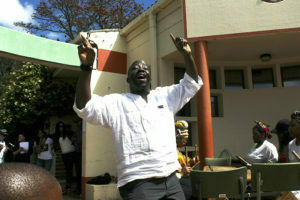At the very end, as at the beginning, he said he said it all in song – a long routine with a gadget so delicate it looked like it was made of paper mache.
Albert Bisaso Ssempeke, an internationally renowned musician who has spent the last three months teaching and lecturing at ILAM, has now left Grahamstown. But last Friday, he was front and centre in Beethoven Hall at the Department of Music and Musicology for an hour of the most captivating use of traditional musical instruments from East Africa.
Born into a clan close to the royal court of Buganda in Uganda, Bisaso’s father (Dr Albert Ssempeke) was royal courtier and singer, the son has continued to be close to Kabaka (King) Ronald Muwenda Mutebi II, who is now a cultural monarch. Bisaso has also made it his life’s mission to keep alive a dying profession – the use of song in Kiganda storytelling, accompanied by traditional musical instruments.
So stunned were the 50-odd audience members by his unusual sound that Bisaso had to add some amusing little story after each song to break the reverie.
“I am so glad I was taken out of my comfort zone,” gushed an audience member as she thanked Bisaso after the show. She said she could not believe she had never had such music, and instruments before in her life. The instruments themselves, while commonplace in Uganda, are rare in Southern Africa (except perhaps at ILAM). Bisaso duly went through some admittedly risqué tales of seduction (of married women!), adultery, betrayal and civil upheaval and “unattractive lasses” with his most powerful instrument – his voice, as he introduced each of the self-crafted amadinda (long-xylophone), endigidi (one-string bowed lute), aduungu (bow lyre), kadongo (lamellaphone) and endere (flute). He later laughed that his audience was lucky he had not unleashed the drums and percussion!
For once also, your reporter understood each word, each cadence, and each pull of the string, as Bisaso went through his routine, perhaps the only audience member to fully follow the show from beginning to end.
It didn’t matter that much though what Bisaso’s words meant however; because his instruments had a rhythm all of their own, perfectly rising to the evening’s occasion while paying tribute to other string and wind instruments from the West and from other parts of Africa. The aduungu can for example, be easily strummed by an accomplished guitarist; the endigidi is Buganda’s version of the violin; the drums and percussion speak basically the same language across the entire world; while the endere would not be lost in the mouth of Najee, one of this writer’s favourite jazz musicians.
The themes are obviously from a time when the Kabaka was the Be-All and End-All; a time when royal courtiers only existed as useful idiots. There is perhaps a little too much mysticism and unpolished animism to some of the tales. Other themes also pre-date American hip hop’s obsession with women’s (er, things), and would infuriate even mild feminists. Fortunately for Bisaso, his wonderful instruments easily drowned out his voice and the words that stuck out were heard by another Ugandan who is only too happy not to disclose anything to the equality commission.
Once again, the unifying force of music was on display last Friday in the Beethoven Room; and Albert Bisaso Ssempeke became the latest manifestation of Uganda having another story beyond that of Idi Amin.




